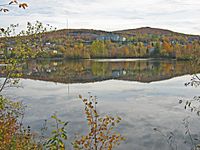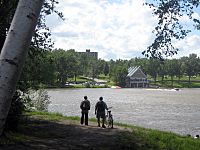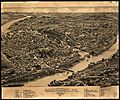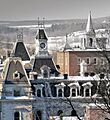Sherbrooke facts for kids
Quick facts for kids
Sherbrooke
|
|||||
|---|---|---|---|---|---|
| Ville de Sherbrooke | |||||
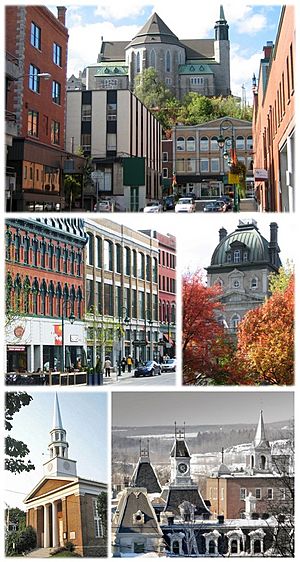
From top, left to right: Downtown Sherbrooke, Wellington Street, Sherbrooke City Hall, Plymouth-Trinity United Church, clock tower at the Sherbrooke History Museum
|
|||||
|
|||||
| Nickname(s):
Queen of the Eastern Townships
|
|||||
| Motto(s):
Ne quid nimis
|
|||||
| Country | Canada | ||||
| Province | Quebec | ||||
| Region | Estrie | ||||
| RCM | None | ||||
| Settled | 1793 | ||||
| Constituted | 1 January 2002 | ||||
| Boroughs |
List
Brompton
Fleurimont Jacques-Cartier Lennoxville Mont-Bellevue Rock Forest–Saint-Élie–Deauville |
||||
| Government | |||||
| • Type | Sherbrooke City Council | ||||
| Area | |||||
| • City | 367.10 km2 (141.74 sq mi) | ||||
| • Land | 353.40 km2 (136.45 sq mi) | ||||
| • Urban | 109.25 km2 (42.18 sq mi) | ||||
| • Metro | 1,458.10 km2 (562.98 sq mi) | ||||
| Highest elevation | 378 m (1,240 ft) | ||||
| Lowest elevation | 128 m (420 ft) | ||||
| Population
(2021)
|
|||||
| • City | 172,950 | ||||
| • Density | 489.4/km2 (1,268/sq mi) | ||||
| • Urban | 155,019 | ||||
| • Urban density | 1,418.9/km2 (3,675/sq mi) | ||||
| • Metro | 227,398(19th) | ||||
| • Metro density | 156/km2 (400/sq mi) | ||||
| • Pop 2016–2021 | |||||
| • Dwellings | 86,019 | ||||
| Time zone | UTC−05:00 (EST) | ||||
| • Summer (DST) | UTC−04:00 (EDT) | ||||
| Postal code(s) |
J1C to J1R
|
||||
| Area code(s) | 819 | ||||
| NTS Map | 21E5 Sherbrooke | ||||
| GNBC Code | EIDHN | ||||
| GDP (Sherbrooke CMA) | CA$8.0 billion (2016) | ||||
| GDP per capita (Sherbrooke CMA) | CA$37,797 (2016) | ||||
Sherbrooke is a city in southern Quebec, Canada. It sits where the Saint-François and Magog rivers meet. This area is known as the Estrie region. Sherbrooke is also the name of a larger area that includes the city itself.
With about 172,950 people living there in 2021, Sherbrooke is the sixth largest city in Quebec. If you include the surrounding towns, the Sherbrooke Census Metropolitan Area (CMA) has about 227,398 people. This makes it the fourth largest metropolitan area in Quebec.
Sherbrooke is a very important city for the Estrie region. It is a main centre for business, government, culture, and education. In the early 1900s, it was even called the Queen of the Eastern Townships.
The city is a big learning hub. There are eight schools and universities with about 40,000 students. These schools also employ 11,000 people, including many teachers and researchers. This brings a lot of money into the city. Sherbrooke has the most university students per person in Quebec.
In the 1800s, Sherbrooke was a busy place for factories. Today, many people work in the service industry, like healthcare and education.
The Sherbrooke area is surrounded by mountains, rivers, and lakes. You can find several places to ski nearby. There are also many fun places to visit. Mont-Bellevue Park, a large park in the city, is a popular spot for downhill skiing.
The city got its name in 1818 from John Coape Sherbrooke. He used to be a Governor General of Canada.
Contents
History of Sherbrooke
Early Settlements and Growth
Indigenous peoples lived in this area between 8,000 and 3,000 years ago. The Abenaki people had names for the place where the rivers meet. They called it Ktinékétolékouac or Kchi Nikitawtegwak, meaning 'the large forks'.
The first non-native person to settle here was Jean-Baptiste Nolain in 1779. The land was first mapped out in 1792. Americans from Vermont built mills in the area around 1802. Gilbert Hyatt led a group of loyalists who settled here in 1803. He built a dam on the Magog River, and soon a gristmill (for grinding grain) and a sawmill were built. The settlement was then called Hyatt's Mills.
The first immigrants from England arrived in 1815. A company called the British American Land Company was started in 1832. They bought a lot of land in the area to develop it.
Railways and Industry
In 1852, a railway line connected Montreal and Portland, Maine, passing through Sherbrooke. By the 1890s, Sherbrooke had train connections to other big cities like Boston, Halifax, and New York City.
More people from other parts of Quebec started moving to Sherbrooke in 1850. By 1871, most people spoke French.
By the early 1900s, Sherbrooke was a busy industrial city. Factories used hydroelectricity (power from water) made nearby. After the 1950s, some of the steel and textile factories closed. More jobs then came from government services and education.
Modern Sherbrooke
On January 1, 2002, Sherbrooke became much larger. It joined with several nearby towns and areas like Ascot, Bromptonville, and Lennoxville.
In 2012, there was an incident at a local factory. This event led to some health concerns in parts of the city.
Geography and Climate
Where is Sherbrooke Located?
Sherbrooke is located where the Saint-François River and Magog River meet. This area is in the heart of the Eastern Townships and the Estrie region of Quebec. The city of Sherbrooke also covers a larger area that is considered a territory equivalent to a regional county municipality.
Sherbrooke's Weather
Sherbrooke has a humid continental climate. This means it has long, cold, and snowy winters. Summers are warm, and spring and autumn are short but clear.
- Winter: From December to February, temperatures are usually below freezing. It snows a lot, about 287 centimeters (113 inches) each year. Sometimes, snow can even fall in May or October!
- Summer: From June to August, temperatures are warm. The average high in July is about 24.6°C (76.3°F).
- Rain: Sherbrooke gets rain throughout the year, but most of it falls in summer and fall. The city receives about 1100 millimeters (43 inches) of rain and snow combined each year.
The hottest temperature ever recorded in Sherbrooke was 36.7°C (98.1°F) in July 1931. The coldest was -41.2°C (-42.2°F) in January 2004.
Sherbrooke's Neighborhoods
The city of Sherbrooke is made up of several different neighborhoods. Some of these include:
- Le quartier universitaire (University district)
- Le Vieux-Nord (Old North)
- Collinsville
- Secteur Galvin
- L'Est (The East)
- Ascot
- Mi-Vallon
- du Pin-Solitaire
- Le Petit Canada
People and Languages
Population Growth
In 2021, Sherbrooke had a population of 172,950 people. This was a 7.2% increase from 2016. The city has grown quite a bit over the years. For example, in 2006, the population jumped because Sherbrooke joined with several nearby towns.
Languages Spoken
In 2021, most people in Sherbrooke (86.4%) spoke French as their first language. About 3.9% of residents spoke English as their first language. Other common first languages include Spanish (2%) and Arabic (1.3%).
Different Backgrounds
Sherbrooke is home to people from many different backgrounds. In 2021, about 88.7% of residents were white. About 9.6% were from visible minorities (people who are not white, Indigenous, or Inuit). About 1.7% were Indigenous. The largest visible minority groups were Black (3.1%), Latin American (2%), and Arab (1.7%).
Economy and Jobs
Sherbrooke's Economic Role
Sherbrooke is the main economic centre of the Estrie region. It is an important place for culture, industry, and education in Quebec. The city has good transportation links, including two railways and four highways. There is also a regional airport nearby.
In 2010, the average personal income in the Sherbrooke area was about CA$30,976. The total economic output (GDP) for the Estrie region was about CA$9.59 billion in the same year.
Some well-known companies started or have operations in Sherbrooke. For example, Sherwood Hockey, which makes hockey equipment, was founded here in 1949. Inglasco, a company that makes hockey pucks, is also based in the city.
Major Employers
Many people in Sherbrooke work for large organizations. As of 2010, some of the biggest employers include:
- Université de Sherbrooke (6,000 employees)
- Centre hospitalier universitaire de Sherbrooke (a hospital, 5,511 employees)
- Commission scolaire de la Région-de-Sherbrooke (school board, 3,050 employees)
- City of Sherbrooke (1,913 employees)
- Desjardins Group (a financial group, 1,713 employees)
- Cégep de Sherbrooke (a college, 800 employees)
- Bishop's University (450 employees)
Arts and Culture
Festivals and Events
Sherbrooke hosts many fun events throughout the year.
- In summer, you can enjoy festivals like the Fête du Lac des Nations, Sherblues & Folk, and the Festival des traditions du monde.
- In winter, the city celebrates with the Carnaval de Sherbrooke.
Architecture and Theatres
The buildings in Sherbrooke, especially in the Vieux-Nord area, show its British heritage.
Sherbrooke has several theatres for music, plays, and dance:
- The Maurice O'Bready University Cultural Centre is the fourth largest theatre in Quebec.
- The Centennial Theatre at Bishop's University also hosts many shows.
- The Théâtre Granada is a historical site known for its original architecture and music concerts.
- The Petit Théâtre de Sherbrooke offers musicals and plays for children.
Since 2007, the Centre des arts de la scène Jean-Besré (CASJB) has helped local artists create and produce their work. It has studios for training in theatre, music, and dance.
Libraries in Sherbrooke
Sherbrooke has several libraries where you can borrow books and learn.
- La bibliothèque municipale Éva-Senécal is the main city library. It is named after Éva Senécal, a poet and journalist.
- There are also libraries in different areas like Rock Forest, Saint-Élie, and Lennoxville. The Lennoxville library offers books in both French and English.
Attractions and Parks
Museums to Explore
Sherbrooke has several museums and visitor centres where you can learn new things:
- Sherbrooke Nature and Science Museum
- Centre d'interprétation de l'histoire de Sherbrooke (History Centre)
- Sherbrooke Museum of Fine Arts
- Centre culturel et du patrimoine Uplands
- Prison Winter (a former prison)
Discover Sherbrooke's Parks
Sherbrooke has 108 parks and green spaces for different activities. Some of the most popular parks include Jacques-Cartier, Mont Bellevue, Bois Beckett, and Lucien-Blanchard.
- Jacques-Cartier Park
This park is located next to lac des Nations, close to downtown. It has sports fields for soccer and tennis. Many festivals are held here, including the Fête du Lac des Nations and the Carnaval de Sherbrooke.
This is the largest park in Sherbrooke, covering 200 hectares (about 494 acres). It has a small ski station on Mount Bellevue. In winter, you can also go cross-country skiing, snowshoeing, or tubing. In summer, it's great for hiking, mountain biking, and jogging. The park has 30 kilometers (18.6 miles) of trails and different types of natural areas.
- Bois Beckett Park
This park used to be a maple grove owned by Major Henry Beckett. It became a city park in 1963. In 2000, it was recognized as an old-growth forest, meaning some trees are very old (the oldest is said to be 270 years old!). You can find trails and old artifacts left by Beckett.
- Lucien-Blanchard Park
This park is on the bank of the Magog River. You can go swimming and play beach volleyball here. You can also rent bicycles, canoes, kayaks, and paddle boats. There's a special centre that teaches about the reptiles and amphibians in the area.
- Marais Réal-D.-Carbonneau
This marsh area is near the Saint-François River. It has wooden walkways and observation towers. You can see over 50 types of trees and shrubs, and many different birds. It's a great place for ecotourism.
Sports in Sherbrooke
Baseball Teams
The Sherbrooke Expos are an amateur baseball team that plays at Amedée Roy Stadium. Sherbrooke has also hosted big baseball events, like some games of the 2002 World Junior Baseball Championship and the 2013 Canada Games.
In the past, Sherbrooke had several professional baseball teams, including:
- Sherbrooke Braves (1940)
- Sherbrooke Canadians (1946)
- Sherbrooke Athletics (1948–1951)
- Sherbrooke Indians (1953–1955)
- Sherbrooke Pirates (1972–1973)
Ice Hockey Teams
- The Sherbrooke Phoenix is a junior hockey team that plays in the Quebec Maritimes Junior Hockey League.
- The Sherbrooke Canadiens was a professional hockey team that played in the American Hockey League from 1984 to 1990.
Transportation in Sherbrooke
Getting Around the City
The Société de transport de Sherbrooke (STS) provides bus service within the city. They have many bus routes, including regular routes, express routes, and smaller routes.
Connecting to Other Cities
- Transdev Limocar offers bus service to Montreal and other nearby cities.
- Sherbrooke is located at the end of A-10, which connects directly to Montreal.
- A-55 connects Sherbrooke to cities like Trois-Rivières and also to Interstate 91 in Vermont, USA.
- A-410 and A-610 are bypass roads around the city.
- The Sherbrooke Airport is located just east of the city, in Cookshire-Eaton. Currently, there are no regular passenger flights from this airport.
Education in Sherbrooke
Education is a very important part of Sherbrooke. It shapes the city's identity and provides many jobs. About 11,000 people work in the city's colleges and universities. Sherbrooke has about 40,000 students studying after high school.
Universities and Colleges
Sherbrooke has five major schools for higher education, offering programs in both English and French. The city has the highest number of university students per person in Quebec.
- The Université de Sherbrooke is a French-language university with over 31,000 students each year. It has eight different faculties, including education, medicine, and management. About 3,000 students are international students from around 100 different countries.
- Bishop's University is one of Quebec's three English-language universities. It is located in the Lennoxville area of Sherbrooke. It has about 3,000 students, mostly in undergraduate programs.
- There are three cégeps (colleges) in Sherbrooke:
- Cégep de Sherbrooke (French)
- Séminaire de Sherbrooke (French)
- Champlain College Lennoxville (English)
Schools for Kids
Public primary and secondary schools in Sherbrooke are managed by either the French-language Centre de services scolaire de la Région-de-Sherbrooke or the English-language Eastern Townships School Board.
Sherbrooke has six public high schools:
- Alexander Galt Regional High School
- École internationale du Phare
- École le Goéland
- École secondaire Mitchell-Montcalm
- École secondaire de la Montée
- École secondaire du Triolet
There are also four private schools that offer secondary education:
- Bishop's College School
- Le Salésien
- Séminaire de Sherbrooke
- Collège Mont-Notre-Dame
Media
Images for kids
See also
 In Spanish: Sherbrooke para niños
In Spanish: Sherbrooke para niños








